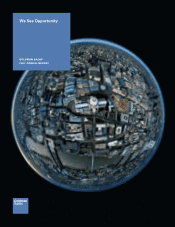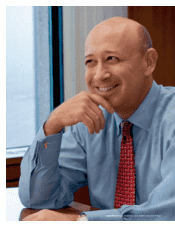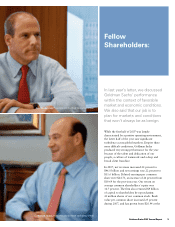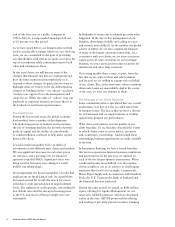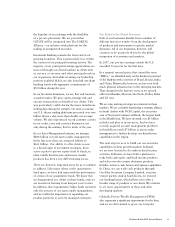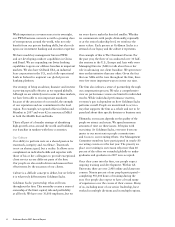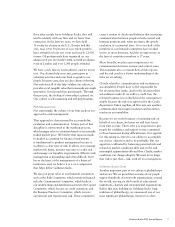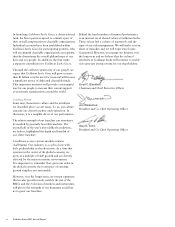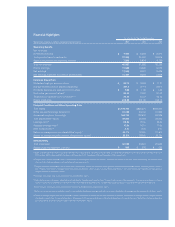Goldman Sachs 2007 Annual Report Download - page 6
Download and view the complete annual report
Please find page 6 of the 2007 Goldman Sachs annual report below. You can navigate through the pages in the report by either clicking on the pages listed below, or by using the keyword search tool below to find specific information within the annual report.end of our first year as a public company in
1999 to $90.43, a compounded annual growth rate
of 20 percent over this period.
As we have stated before, our business does not lend
itself to predictable earnings. However, over the long
term, we are committed to the goal of providing
our shareholders with returns on equity at or near the
top of our industry while continuing to grow book
value and earnings per share.
In this year’s letter, we will discuss some of the
changes that financial markets are undergoing and
how the firm’s institutional strengths help us to
respond to these changes. In particular, we want to
highlight what we believe to be the differentiating
element of Goldman Sachs
—
our culture
—
and how
it infuses our approach to risk management and
client service. While the value of “culture” may not
lend itself to empirical analysis, we know that it is
the bedrock of our financial performance.
The Credit Cycle
During the last several years, the global economy
has benefited from a number of developments.
The global integration of markets and economies,
the rise of emerging markets, the growth of private
pools of capital and the ability of central banks
to combat inflation coalesced to help make capital
historically cheap.
A world awash in liquidity led to an influx of
investments across different asset classes and markets.
We saw significant increases in real estate prices,
for instance, and a growing role for financial
sponsors in global M&A. Significant value was
being created, but many were asking if a credit
bubble was taking shape.
Not surprisingly, the broad availability of credit had
implications on the pricing of risk. As capital flows
increased around the world, the search for excess
yield drove credit spreads down to unprecedented
levels. The tightness in credit spreads, extraordinarily
low default rates and the run-up in housing prices
in the U.S. and much of Europe simply were not
sustainable.
In hindsight, it seems easy to identify precisely what
happened. In the day-to-day management of our
business, identifying a bubble and calling its exact
end is much more difficult. As the number one global
adviser in M&A, we are also a significant financier
of many of the largest corporate transactions. As a
co-investor with our clients, we are active in private
equity and real estate investing. In our mortgage
business, we price assets and structure securities for
institutions and other large investors.
Our strong market share comes, in part, from the
fact that we are active in these and other markets,
and because we are willing to assume risk on behalf
of our clients. But, at the same time, when conditions
deteriorate, losses are unavoidable. And in the course
of the year, we were not immune to them.
The Strength of our Client Franchise
Some commentators have speculated that our overall
performance was due to a few so-called smart bets
to mitigate losses. The fact is that we have a diverse
set of businesses and no single business or trading
opportunity dictated our performance.
What drove performance was the quality of our
client franchise. To us, franchise describes the extent
to which clients come to us for advice, execution
and, sometimes, partnership. And through these
relationships, business opportunities are made available
to the firm.
In Investment Banking, we have a broad franchise
that serves corporations, financial sponsors, institutions
and governments. In the last year, we advised on
each of the five largest sponsor transactions. When
conditions became more difficult over the summer,
clients sought us out as an advisor in challenging
situations they faced
—
for example, Countrywide,
Home Depot Supply and, in connection with Northern
Rock, the U.K. Treasury, the Bank of England and
the Financial Services Authority.
During the same period, we priced an $896 million
equity offering for Apollo Management on our
innovative GSTrUE platform, which we developed
earlier in the year. GSTrUE pioneered the offering
and trading of privately placed securities, bringing
4Goldman Sachs 2007 Annual Report

